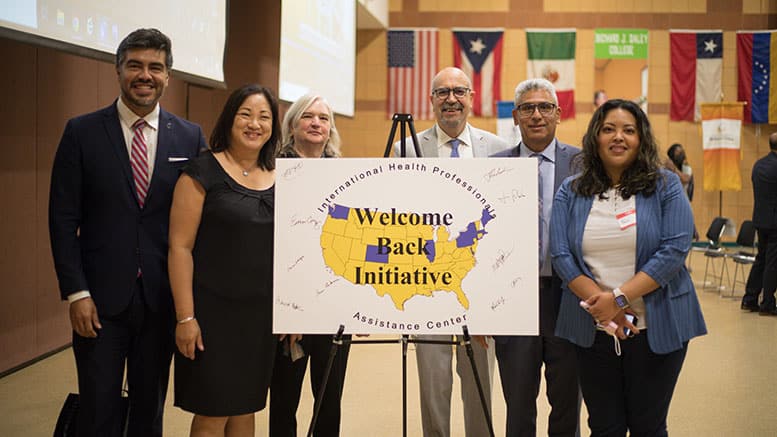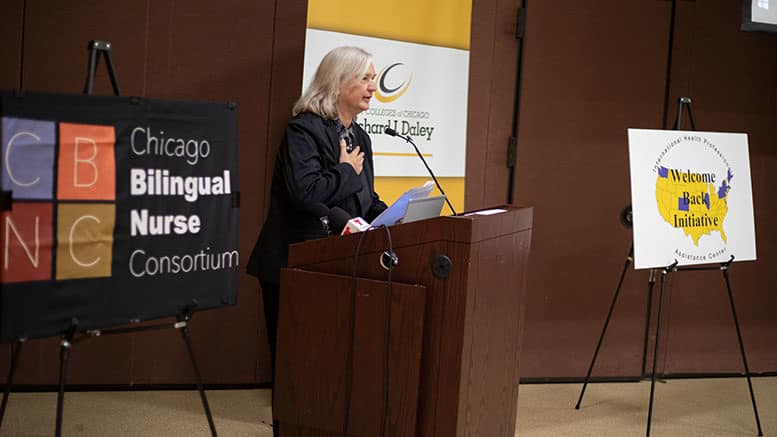Luis Espinoza’s ordeal to be able to practice as a nurse in the U.S. is a cautionary tale. Despite immigrating from Mexico to Chicago in 1999 with a nursing degree and returning to obtain a Mexican nursing license in 2008, a lack of knowledge of Illinois nursing credential requirements, poor English and lack of financial resources led to a 20-year-long odyssey to resume his profession in the U.S.
During that time, Espinoza worked numerous less lucrative and rewarding jobs, and then had to retake an entire nursing associate degree program at Malcolm X Community College in Chicago before he was finally able to obtain state licensure and practice as a nurse in the Windy City in 2020.
In August, City Colleges of Chicago and Richard J. Daley College – a Hispanic-serving institution – in partnership with the Chicago Bilingual Nurse Consortium (CBNC), announced the opening of the Chicago Welcome Back Center (CWBC), a resource for immigrant professionals that is designed to address the problem.
The center, located at Arturo Velasquez Institute at Daley College, will help immigrants with professional degrees and licenses obtained abroad re-enter their profession or establish a related career in Illinois. In particular, it will initially focus on guiding students who are internationally educated and licensed nurses through the credential and licensing process to be able to work as a registered nurse or a health professional in Illinois. There are already 50 immigrant professionals receiving a variety of services through the center, says Daley College President Janine Janosky.
Bridging out
The Welcome Back Initiative is a 21-year-old national organization that support educational bridges for international healthcare professionals’ reemployment in the U.S. and establishes the structure for its centers throughout the country. There are 10 centers in California, Washington (2), Texas, Colorado, New York (2), Connecticut, Pennsylvania, Maryland, Massachusetts and Rhode Island, some of which are collocated at community colleges. The Chicago Welcome Back Center is the first such center in the Midwest.
“The Welcome Back Initiative has grown ‘upon request,’” says José Ramón Fernández-Peña, its founder and executive director. “Each new Welcome Back Center (WBC) was established when a local group or institution requested our technical assistance to help them launch it. After an inquiry, we go through a thorough an assessment to determine if it’s feasible to open a center: is there a need, are there funds available, are there willing partners, what kind of opposition might we encounter, is there political support?”
Related article: A workforce bridge for refugees, immigrants
The Chicago WBC will benefit from services provided by CBNC, which has assisted internationally educated nurses to pursue licensure in the U.S. for 20 years and which now has a satellite office on the Daley College campus, increasing student access to its services and access to bilingual speakers. The center will also provide to the college services such as ESL student support services, networking and career services.
The center itself features a meeting room, and a reception area and three private offices so that the participants can share their stories, Janosky says. It is staffed by a program director and an educational case manager who are Daley College staff. All told, it cost $250,000 to build out the physical space and will cost $150,000 annually to provides salaries and associated services to staff the center.
A variety of challenges and solutions
Immigrant professionals face a variety of challenges in practicing their professions in the U.S. The first is an awareness of what is required to practice in a particular profession in a particular state.
Chicago WBC staff can help immigrants secure credential and licensure evaluation services that translate foreign credentials and map professional educations and licenses received abroad to requirements for that professional in a particular U.S. state. That can vary by profession, with significant recognition of foreign professional education for nursing and almost none for physicians. Sometimes there are gaps that can be filled with discrete community college education.
“We ask them, ‘Were you a nurse in your country?,’” says Silvia Villa, director of continuing education at Daley College. “And when they say, ‘yes,’ then you have to break it down further and determine if it was a licensed nursing degree or not or if they’re a nurse’s assistant, as some of these countries have technical careers in nursing.”
The center also can help with English proficiency. Without a solid general command of English, and the significantly higher standard of an ability to use the specialized knowledge of their profession in English in work-related activities, foreign professionals will not be able pass the National Licensing Examination (NCLEX) for nursing nor secure employment. The center and many community colleges offer specialized language programs tailored to the vocabulary of specific professions, contextualized ESL and instruction matching their English fluency, which for immigrant professionals is often higher than the general immigrant profession.
Another challenge is making professionals aware of career tracks and job availability. Providing knowledge of the marketplace can steer immigrants to where need is the greatest and map particular training and experience required for such paths. WBC staff assist participants in exploring and pursuing alternative careers in healthcare while they are on the path towards licensure, and it provides referrals to educational, community, and professional programs and organizations.
Daley College also provides intake of professional students that assesses immigrant professional student needs in the areas above and assess when the student should take the NCLEX exam.

A national structure study
Immigrant professional pathways efforts may get a boost from new legislation. In September, Congress passed the Bridging the Gap for New Americans Act, which calls on the U.S. Department of Labor to study systemic barriers that impact employment opportunities for immigrants and refugees who hold credentials obtained in another country and to issue recommendations for reform. President Joe Biden in October signed the bill into law.
“The study also calls for analysis of available public and private resources to assist immigrants and refugees to better utilize the education and experience that they already bring to the country,” says Fatima Sanz, senior policy manager at non-profit social enterprise and credential evaluation provider World Education Services.
The potential for two-year colleges and a few caveats
Community colleges are ideally positioned to play a major role in supporting the inclusion of immigrants and refugees who have credentials from another country, Sanz says: “They offer a vast array of credit, as well as non-credit, courses and short-term vocational certificates, which allow immigrants and refugees the opportunity to advance their language skills, but also prepare for better jobs, or even graduate school or professional licensure in the in the U.S.”
With respect to the Chicago WBC, there is no telling how large the program could become, Janosky says.
“We have a number of large immigrant communities in Chicago and we estimate 10% of all identified immigrants arriving within the last five years – which is more than 10,000 potential students – would participate in this kind of a program,” Janosky says. “And while we’re starting with nursing, we have plans to move into other professions.”
Other efforts
There are many other community colleges providing notable immigrant professional pathway programs. Northern Essex Community College (NECC) in Massachusetts has offered such services through its PIES Latinos de NECC program since 2016 and has now served more than 1,000 foreign-educated students and professionals from 11 countries, notes Noemí Custodia-Lora, vice president of the Lawrence Campus and community relations at NECC.
She says the program is expected to remain a transitional support service rather than a source of paying students.
“We have found that this is not a pipeline to bring students to academic programs; this is more of a pipeline for students to go into workforce training,” Custodia-Lora says.
Another community college, Howard Community College in Maryland, offers a robust array of services and courses to support internationally trained immigrant professionals, but it has seen low enrollment so far and continues to look for ways to engage the population and grow enrollment, says Rosie Verratti, senior director of languages and culture in the college’s continuing education and workforce development division.

